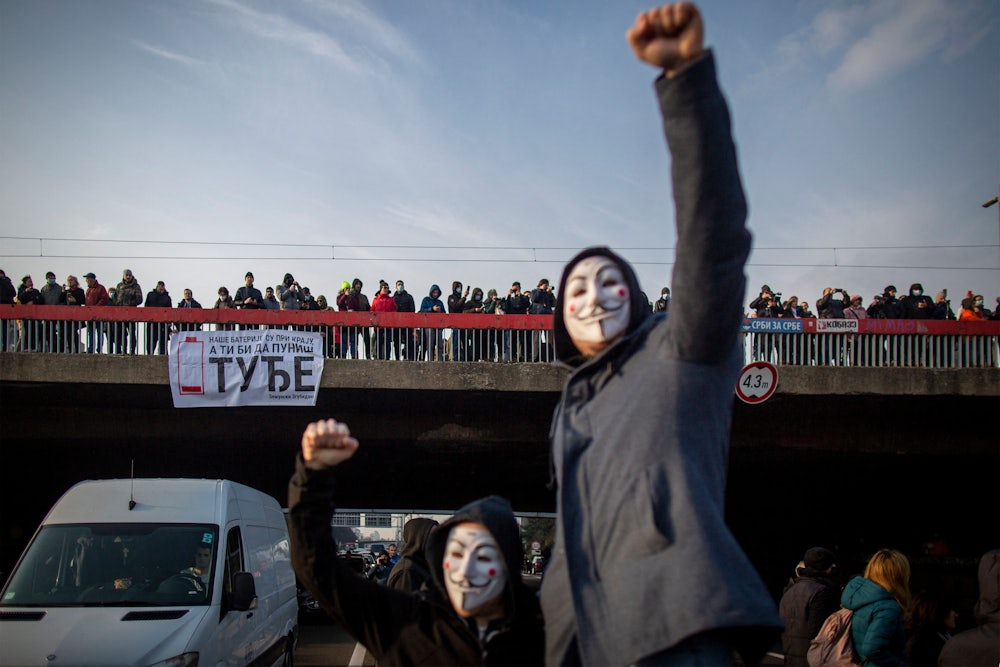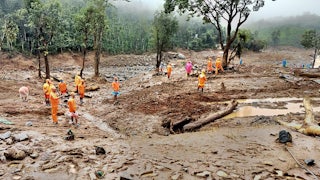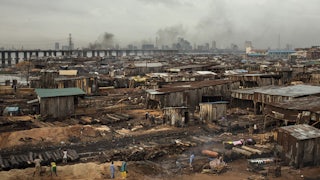On her way to sing at a birthday party last month, Croatian pop star Severina Vučković was stopped and questioned about her political views by Serbian authorities. Around the same time, Aleksandar Matković started receiving death threats on Telegram. The first was in Serbian: “We will follow you until you disappear, scum.” A subsequent text was written in what Matković—a Serbian academic at the Institute for Economics in Belgrade who studies Marxism and economic history—described to me as “garbled German.” Another showed that the sender was just over a quarter-mile from the home of a friend he was visiting on the Adriatic Coast. Also around the same time, teams of police, armed with search warrants, showed up at the homes of five members of the environmental group Eko Straža (Eco Guard) and confiscated their cell phones and laptops.
What do the pop star, the academic and the environmentalists have in common? Like the tens of thousands of people who’ve rallied across Serbia in recent weeks, they’ve all spoken out against the Anglo Australian mining firm Rio Tinto’s $2.4 billion plan to mine and process lithium in that country’s verdant Jadar Valley, near the town of Loznica. The company has said that the site could eventually produce 58,000 tons of lithium per day—enough to meet 90 percent of European lithium demand and power some one million electric vehicles. The Serbian government has eagerly backed the project. It’s also garnered the enthusiastic support of the European Union and the United States, which on Wednesday signed an agreement with Serbia for strategic cooperation in energy. The EU, especially, hopes it can help diversify a supply chain now heavily concentrated in China and secure the bloc easier access to a mineral that’s central to its electric vehicle–centric green industrial policy goals.
Many Serbians, though—including those who’d live closest to the project—worry it will devastate the region’s agricultural production and poison the drinking water for millions. Critics argue it promises few upsides for either local residents or the majority of Serbians. Demonstrators want the project canceled. It wouldn’t be the first time that’s happened: After mass protests in 2022 shut down cities and railways, Serbia’s government revoked its approval of Rio Tinto’s plan for the Jadar Valley site in advance of federal elections that April, blocking further development. On July 11, 2024, Serbia’s Constitutional Court ruled that the decision was unconstitutional, laying the groundwork for the government to let Rio Tinto move forward.
Alongside a new wave of protests has come a new, more intensive wave of repression. Once news broke that Severina had been stopped at the border—she was eventually allowed to pass—Serbian Interior Secretary Ivica Dačić said that she and other regional celebrities would be removed from “lists” of people whose public stances the government considers problematic. People who’ve participated in protests further report being questioned by police over Instagram posts, and might face criminal charges that could mean they spend years in prison. Rio Tinto is now attempting to have peer-reviewed research on the environmental impact of the Jadar project substantially changed or redacted, insisting—alongside high-ranking members of Serbia’s ruling party—that its authors are spreading “disinformation.”
Bojan Simiśić is the founder of Eko Straža, although his home wasn’t among those searched by police in August. Members of that group are now waiting to see whether the government will build a case against them for calling for a “violent change in the constitutional order,” a felony charge. Such serious charges are a new development since the last round of protests, Simiśić says. “In 2021 there were police at my door. They came just to warn me” not to organize or participate in protests, he said. More often, demonstrators were issued tickets fining them around 50 euros for minor infractions. “Now they’re getting more aggressive,” Simiśić added. “It’s not just about the mine. We have to fight for basic liberties to protest.” In response, Simiśić helped organize a protest that drew tens of thousands of people to the grounds of state-run media outlet RTS on September 1, opposing the mine, the government’s treatment of protesters, and the silence around both from Serbia’s tightly controlled media environment. Serbian officials did not respond to multiple requests for comment on this story.
At the end of last month, a website run by an “independent citizens’” group calling itself “Kopacemo” (We Will Dig) appeared, claiming to fight “misinformation.” The page features a registry of so-called “ecological terrorists,” including Matković and Simiśić. Profiles of several dozen alleged ecoterrorists feature stylized black and white pictures set against cyberpunk-ish green and black backgrounds. Descriptions list whether they’ve been arrested and take personal pot shots. Matković’s listing starts off by saying he “has a speech impediment and tics” and “can’t pronounce his Rs and Ls properly.” A profile for another anti-mining activist states that he “wears a bandanna over his head in a militant style,” which is “actually to cover the loss of his hair.” Vladimir Štimac, a former basketball player featured on the site, has now filed a criminal complaint against its anonymous creators. Though it’s still unclear who exactly is behind the site, the group did indicate on X that it would give power of attorney to fight Štimac’s charge to Vladimir Đukanović, a lawyer and member of the Serbian National Assembly with Serbian President Aleksandar Vučić’s’s ruling Serbian Progressive Party, or SNS.
The powerful governments backing the Jadar Valley project have been relatively quiet about the protests against lithium development in Serbia; the government’s crackdown on dissent; and ominous, anonymous threats to mining critics. That may be because of just how anxious they are to unlock sources lithium, a critical component in the batteries that power electric vehicles, cell phones, and other technologies. The Eurozone’s largest economy, Germany, is facing persistently high levels of unemployment. Its industrial sector has struggled amid low demand and high interest rates.
Since Russia’s invasion of Ukraine, Germany has been forced to grapple with its decades-long reliance on cheap Russian gas not just to heat homes but to make chemicals and cars too. Historically important automakers like Volkswagen and Mercedes-Benz owner Daimler are laying off thousands of workers as they adjust to sluggish European demand, foreign competition, and electrification. China’s somewhat chaotic quest to become a world-class E.V. manufacturer has started to bear fruit with juggernauts like BYD, which is now ably competing with U.S. and European E.V.s. America’s protectionist-minded investments in its own E.V. sector, though, have riled Europeans bound by their bloc’s strict spending and state aid rules, which largely prohibit the sorts of massive subsidies now flowing to U.S. automakers from the Inflation Reduction Act. To spur investment in its own green sector, the European Commission earlier this year passed the Critical Raw Materials Act, meant to build up the bloc’s supplies of and access to so-called critical minerals.
Not much is known about the strategic cooperation agreement the United States and Serbia signed this week. Per remarks from Jose W. Fernandez—under secretary for economic growth, energy, and the environment—the agreement is meant to “expand opportunities for U.S. companies to invest in Serbia’s energy sector, including in green energy projects,” and will create a “level playing field” for U.S. companies that want to do business there. “This agreement represents a multiyear effort, involving the close attention of specialists from five U.S. agencies,” a State Department press release notes. “This commitment of resources reflects the U.S. Government’s strong support for U.S. investors and clean energy projects, as a means to drive a green transition and sustainable development.” Lithium isn’t mentioned in the official announcements put out by either country.
The Serbian government, of course, has plenty to gain from Jadar’s lithium. The project is well aligned with Vučić’s quest to attract foreign direct investment to Serbia by any means necessary. As Matković noted in the op-ed that attracted the threats, foreign investment in Serbia’s mining sector increased sixfold between 2021 and 2023, jumping from $132 million to $784 million; Serbia’s gross domestic product, meanwhile, has stagnated.
Not unlike U.S. cities’ bids to attract an Amazon headquarters, Serbians have found that courting big corporations often comes at a price: tax giveaways, weakened labor and environmental protections, and profits carried off to Frankfurt, New York, and the City of London. “I think Serbia has reached a plateau when it comes to the impact of foreign direct investment,” Matković said. “We subsidize the hell out of foreign companies without any budget limitations. The more we subsidize, the less money there is and the more we need to go out and get from foreign investors.” Vučić’s ruling SNS party has courted high rollers from geopolitical rivals in order to fuel that cycle, drawing investments from China, Russia, and the West even as those powers fight among themselves.
Having gotten his start in politics on the far right before serving as Slobodon Milošević’s minister of information, Vučić has gradually moderated on certain fronts while consolidating control over Serbian media, state security forces, and his own party. Elections in Serbia are ostensibly competitive, yet the SNS has maintained virtual one-party control over Serbian politics and state institutions for over a decade. Though occasionally critical of Vučić’s ties to Putin—particularly since Russia’s invasion of Ukraine—EU and U.S. leaders have been willing to overlook some of the Vučić government’s more authoritarian tendencies as its lithium reserves become a more realistic, attractive prospect. That could open the door to Serbia’s long-awaited ascension to the EU.
German Chancellor Olaf Sholz visited Serbia less than a week after Rio Tinto got its exploration license back. Alongside Vučić, Sholz oversaw the July 19 finalization of a memorandum of understanding between Serbia and the European Union. European Commission Vice President and Green Deal czar Maroš Šefčovič attended the summit, as well. So did representatives from the Mercedes-Benz and Stellantis European carmakers now working on their own agreements for access to Serbia’s lithium for their E.V.s. The EU-Serbia deal establishes a strategic partnership between the bloc and the Western Balkan Nation to co-develop value chains for raw materials, batteries, and electric vehicles, aimed (per the European Commission) at supporting “the development of new local industries and high-quality jobs along the electric vehicle value chain in full respect of high environmental and social standards while addressing the concerns of local communities with full transparency.”
It’s not clear that the Rio Tinto mine is respecting “high environmental and social standards,” though. A peer-reviewed study published in July in Scientific Reports, a journal published by Nature, states that proposed lithium mining in the Jadar Valley could present “a constant threat of contamination” to local waterways and endanger the water supply for about 2.5 million people—roughly a third of the country. The study was based on an analysis of water, sediment, and soil samples collected from experimental drilling sites, deep mines, and the nearby Jadar and Korenita rivers—upstream, at, and downstream of the mine site where Rio Tinto has begun conducting exploratory activities.
Researchers found that the water downstream from the site had a mineral fingerprint for arsenic, boron, and lithium that was “identical” to what they found in deep mine waters, explained Jovan M. Tadić, a co-author on the report and affiliate scientist at Lawrence Berkeley National Laboratory’s Climate Sciences Department. “Upon reaching the site, it was immediately apparent that something was wrong,” Tadić said, over email. “Plant growth around the drill sites was stunted, and the area was littered with unsightly concrete and steel structures left behind after the drillings.”
The resource slated to be mined in the Jadar Valley is a unique mineral compound known as jadarite ore, found not long after Rio Tinto began exploring the area in 2004. Besides lithium, it contains “significant amounts of boron and arsenic, which will be, in some form, by-products of this mine. In our study, both were found to be leaking from the experimental drilling,” Tadić notes. The process for extracting lithium from jadarite is somewhat novel; a Rio Tinto patent for recovering valuable materials from jadarite—including lithium and boron—was just approved in August.

In response to the Scientific Reports article, Rio Tinto’s chief scientist, Nigel Steward, sent a letter to the journal’s editors asking for the study—which underwent two rounds of peer review—to be “substantially changed” or redacted. Joining Steward were Aleksandar Jovović, Aleksadar Cvjetić and Nikola Lilić, all faculty at the University of Belgrade. All three were commissioned by Rio Tinto to create draft environmental impact assessments of the Jadar project; those assessments, undertaken voluntarily, are separate from those that the company will be legally required to conduct if the project advances. The company filed a request with Serbian regulators this week to begin establishing the scope and content of that environmental impact assessment. A spokesperson for Rio Tinto, Nikola Velickovic, noted over email that Rio Tinto “doesn’t have control” over the conclusions made by independent experts, and that covering the costs of such studies is standard practice for mining firms. She added that it “is not in the professional interest of the independent experts to be influenced in their analysis and conclusions, as that would damage their credibility.”
Their complaints focused primarily on three areas: that authors overstated the size of the project area; that they didn’t establish baseline findings, from before drilling had started; and that they had ignored the possibility that the contamination observed in their samples could have come from another source. Tadić acknowledged the paper had one minor typo that was “completely irrelevant” to its conclusions, but sees the call for more substantive changes (or retraction) as “baseless.” While Rio Tinto defines the parameters of its operations as the mine site itself, Tadić and his colleagues analyzed the much larger entire area that would be “seriously affected by the mining operations, regardless of the nature of such operations. We used official numbers from the public and cited documents.” They collected samples upstream of mining operations as a means of getting around not having baseline samples from before drilling began. “We did not take samples before drilling began,” he said, “because we did not know where drilling would occur.” Scientific Reports did not respond to multiple requests for comment on this story. As of publication, no changes to the article have been made.
Asked to respond to the claims in the Scientific Reports study, Chad Blewitt, managing director of the Jadar project, began by calling Ratko Ristić—one of the co-authors—an “aspiring politician.” He argued that the article was all a part of the “same disinformation” the company had been dealing with since 2021, referencing an article lead author Dragana Đorđević published that year. He directed me to Stewart’s letter to Scientific Reports and the draft environmental impact assessments commissioned by Rio Tinto. “There is a persistent campaign of disinformation from those two authors—I can’t speak to the other authors—against the project,” Blewitt said.
Ristić, who is from Loznica, where the mine is based, did indeed run as the ultranationalist National Unity coalition’s Belgrade mayoral candidate in 2023. He’s also the dean of the University of Belgrade’s Faculty of Forestry, and has published over 130 research papers dealing with erosion control, land degradation, hydrology, and other water management topics. As the Serbian news outlet N1 pointed out, Đorđević—a professor at the University of Belgrade’s Center of Excellence in Environmental Chemistry and Engineering—has authored or co-authored more than 130 academic publications listed on the database ResearchGate. Rio Tinto head scientist Nigel Steward has just three.
The University of Belgrade’s Faculty of Biology has publicly distanced itself from Rio Tinto’s draft environmental impact assessment. Department faculty were recruited by a consultant to do fieldwork at the Jadar site in 2020, the results of which were eventually integrated into the draft environmental impact assessment Rio Tinto released in June. The biologists found that the Jadar project would have an “extremely significant” impact on local biodiversity and that the measures the company proposed to mitigate those impacts were insufficient. They disassociated themselves from the resulting report, they wrote, over concerns about “inadequate and incorrect presentation” of key data, risk factors, proposals for protection measures and conclusions” in the published results of their study. Those were reviewed and edited by a Cambridge-based biodiversity consultancy, which the professors say is ultimately responsible for what went into the draft environmental impact assessment. Vučić called their warnings about the project “brutal lies.” In a statement to the press, Rio Tinto said it welcomed the faculty’s attempts at “clear and precise communication” about the Jadar project, though warned their statement could “mislead the public.”
Blewitt repeatedly referred to a disinformation campaign throughout our conversation. “We have never seen a disinformation campaign like this anywhere in the world,” he told me, while saying the company has sought “common ground” via community engagement sessions with local residents during its time in Serbia. Asked where all that disinformation was coming from, Blewitt laughed and said, “You’re the reporter,” refusing to clarify who or what might be behind such a campaign. He denied that Rio Tinto had any involvement in the threats against Matković, Kopacemo, or the Serbian government’s treatment of mining critics.
Governmental officials have similarly suggested opposition to the mine is part of a shadowy disinformation campaign. Vučić has frequently implied that outside forces are plotting to overthrow his government. He’s repeated that message in response to this most recent round of protests, accusing mining critics of attempting to carry out a “color revolution.” It’s a reference to the often Western-backed ousters of Eastern Bloc leaders, like the revolution that overthrew the Milošević government in which Vučić served. Assembly president and former Prime Minister Ana Brnabić has made similar claims, speculating that Rio Tinto detractors are receiving “financing” on the order of tens of millions of euros to carry out a “campaign of disinformation and a campaign of spreading lies and fake news with the aim of destabilizing Serbia.” Russia, in turn, which Vučić credited for his coup intel, has praised his government for “countering these attempts, in defending those principles that cause irritation in the West.”
The U.S. ambassador to Serbia, Christopher Hill, has also recently stated publicly that opposition to lithium mining in Serbia is the result of disinformation—from Russia. “If you look carefully at some of these people out on the streets,” Hill said at a conference last week, “they were not Western environmentalists. They were Russia supporters.” Hill elaborated that demonstrations featured “people who were quite comfortable there defending Russia’s position in the world. And there they were out there protesting a lithium decision. What were they protesting? Are they so worried that Serbia may end up as a leader in electric vehicles? Is that what they were concerned about? Or were they concerned about something deeper? And I think what is going on is, to some extent, there is a counterattack against Serbia moving westward.”
A spokesperson for Hill’s office declined to substantiate those claims on the record or respond to questions about crackdowns on peaceful protesters and the targeting of scientists. The State Department’s Assistant Secretary for Energy Resources Geoffrey Pyatt—who recently voiced his support for Rio Tinto’s plans on X—also declined to answer specific questions about the project, sending a more general statement over email. “The citizens of Serbia understandably want to see this project developed in a way that respects the highest environmental, social and governance standards,” Pyatt wrote. “Ultimately, the sovereign decision regarding the issue of lithium will be made by the Government of Serbia, with intensive dialogue with its citizens, scientists, environment and mining experts.” Like Hill, Pyatt suggested Russia has “instrumentalized protests to pursue its own agenda in Serbia, as it does around the globe.”
Pundits and politicians friendly to the Russian government, including right-wing extremists, have attended protests and otherwise spoken out about their opposition to lithium mining in Serbia. Protest organizers were outraged, however, at the suggestion that tens of thousands of people around the country were being manipulated by shadowy outside forces. “That’s just pure propaganda,” said Bojana Novakovic, a Serbian Australian actress who’s been active in the anti-mining group Marš Sa Drine. “We have nothing to do with Russia. The fact that there are individuals at protests who might support Russia is just as irrelevant as the fact that there are people at protests who want to be part of the European Union.”
A spokesperson for the European Commission, Johanna Bernsel, declined to respond directly to questions about the contents of the Scientific Reports study, Rio Tinto’s attempts to have it altered or redacted, and the repression faced by mining critics. “We are aware of the scientific discussions about the environmental effects of this project, discussions which include but are not limited to the study you mention,” Bernsel wrote in an email. “Whoever exploits any mine in the world in response to the global demand for critical raw materials should do it in a framework ensuring that the world’s highest environmental standards are applied.”
What’s happening in Serbia isn’t an anomaly. The threats facing Serbian activists are in some cases less dire than what their counterparts elsewhere face regularly. A report released last week from the nonprofit Global Witness found that mining was “by far” the biggest driving force behind killings of environmental defenders. Of the 196 environmental defenders killed worldwide last year—actual numbers are likely far higher—25 were killed as a result of fights against mining and extraction projects; 23 of those killings were in Latin America. Neither is it historically uncommon for rich countries to stomach authoritarians and look the other way for the sake of cheaper raw materials. The only novelty now is that they’re doing so in the name of fighting climate change.
Climate policies meant to reduce emissions as quickly as possible, though, would probably focus elsewhere: on expanding and improving less resource-intensive forms of mass transit, for instance, and reducing carbon-intensive sprawl and car dependence simultaneously. Lithium would be important in either case; it’s not wrong to want to diversify hyperconcentrated supply chains. But the U.S. and EU’s intense focus on electric vehicles suggests that they’re likely more interested in protecting their own legacy industries than the planet’s chances of flying past two, three, or four degrees Celsius of global warming.
As temperatures rise, the climate crisis is inflicting damage farther and farther north. Richer places once thought to be insulated from the extreme weather are now grappling with inescapable wildfires, unbearable heat and uninsurable homes. How countries respond to that crisis will alter landscapes in other ways. “If this is normalized in the Balkans—an already shaky region—I’m not sure what the green transition is going to look like,” Matković tells me. Serbia is already a source of precarious, outsourced labor for Chinese and European companies. If the Rio Tinto project goes through there, activists fear Serbia will become a de facto resource colony of the EU’s wealthiest nations. And Serbia could be a preview, Matković worries, of what an uneven, too-slow energy transition has in store for many other less-developed countries peripheral to major powers and their climate plans: “a violent and escalating situation in which raw materials and minerals are extracted from the periphery so the middle classes in the U.S. can continue to exist in the twentieth century and have cars as a status symbol.”








